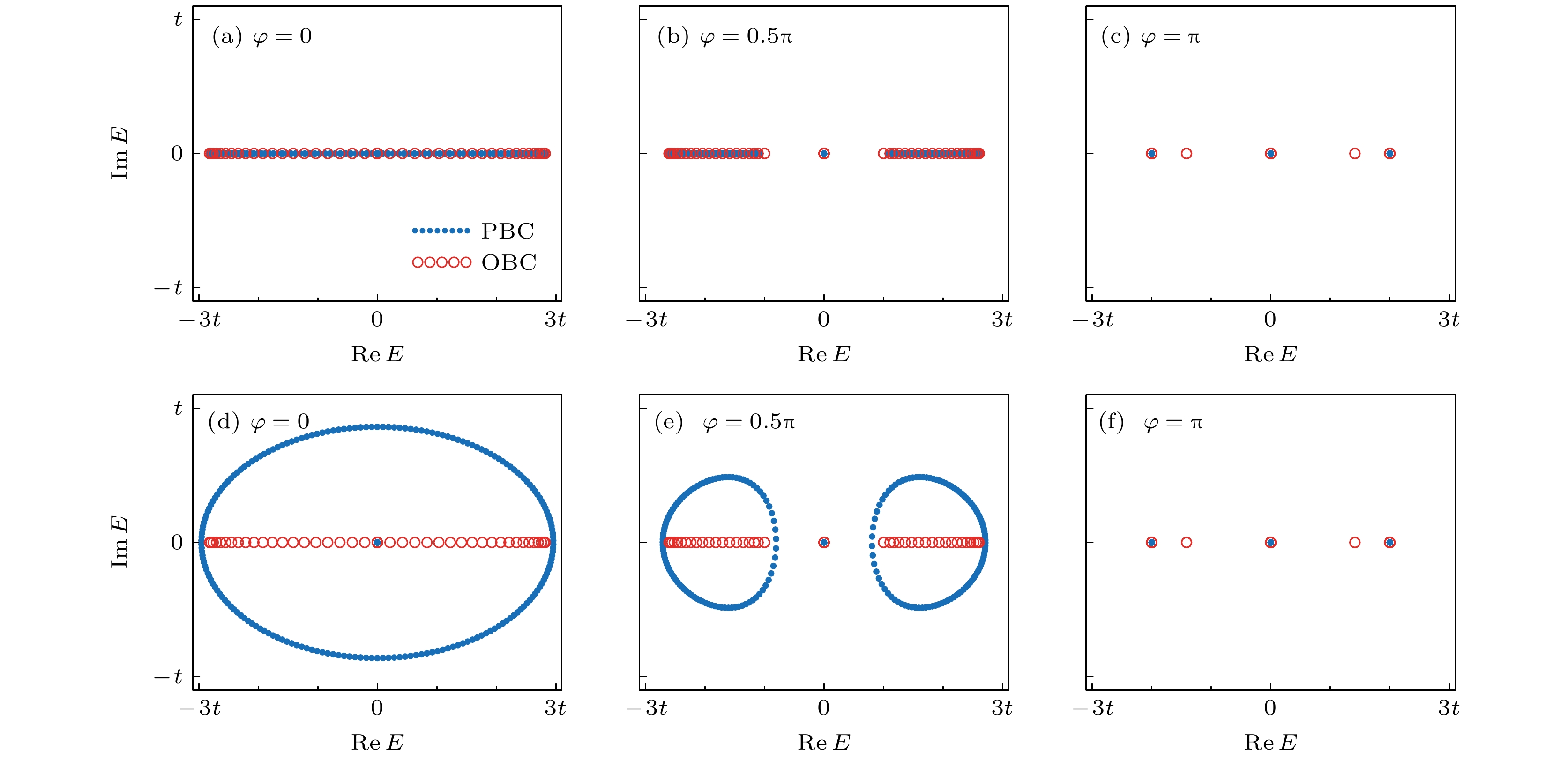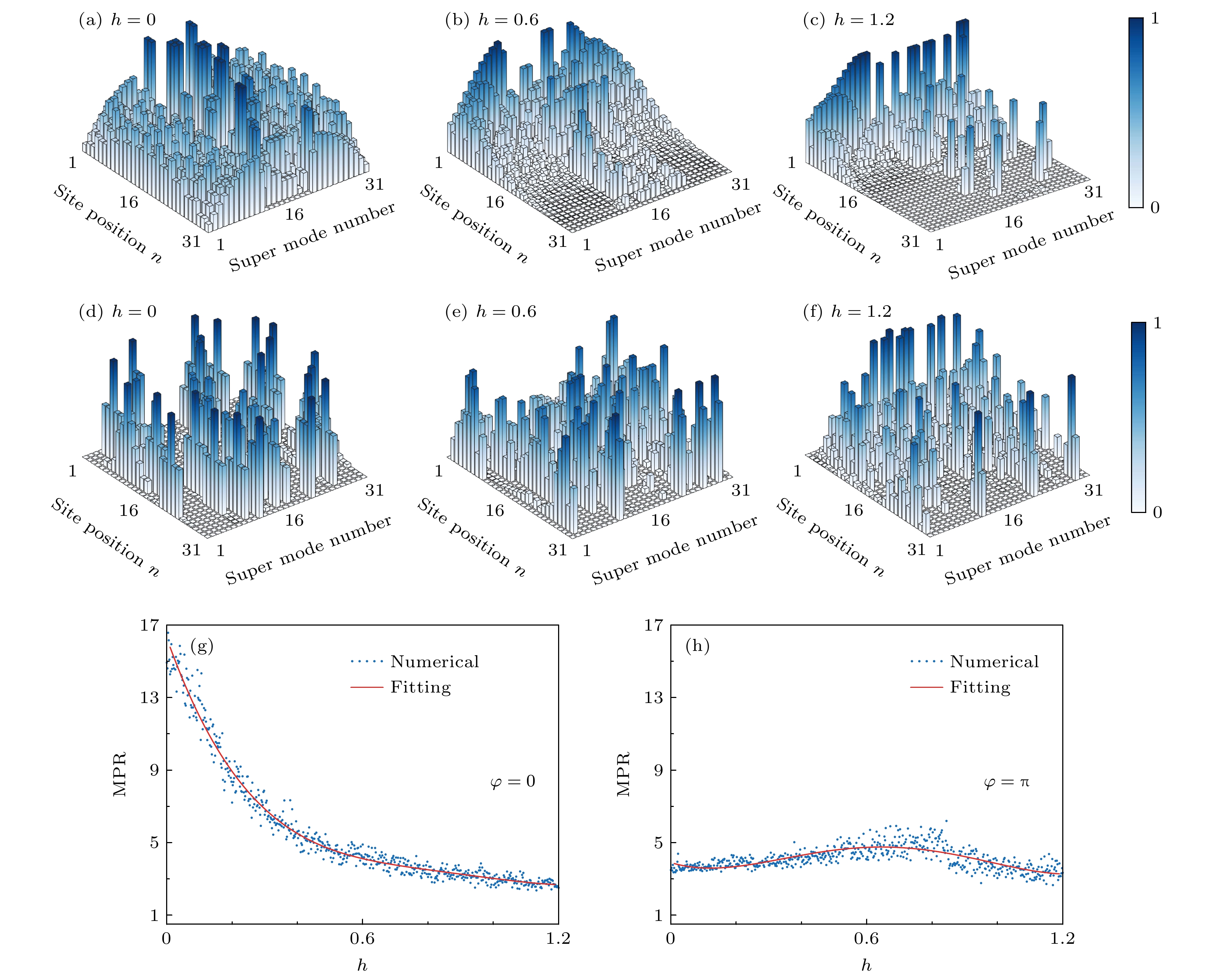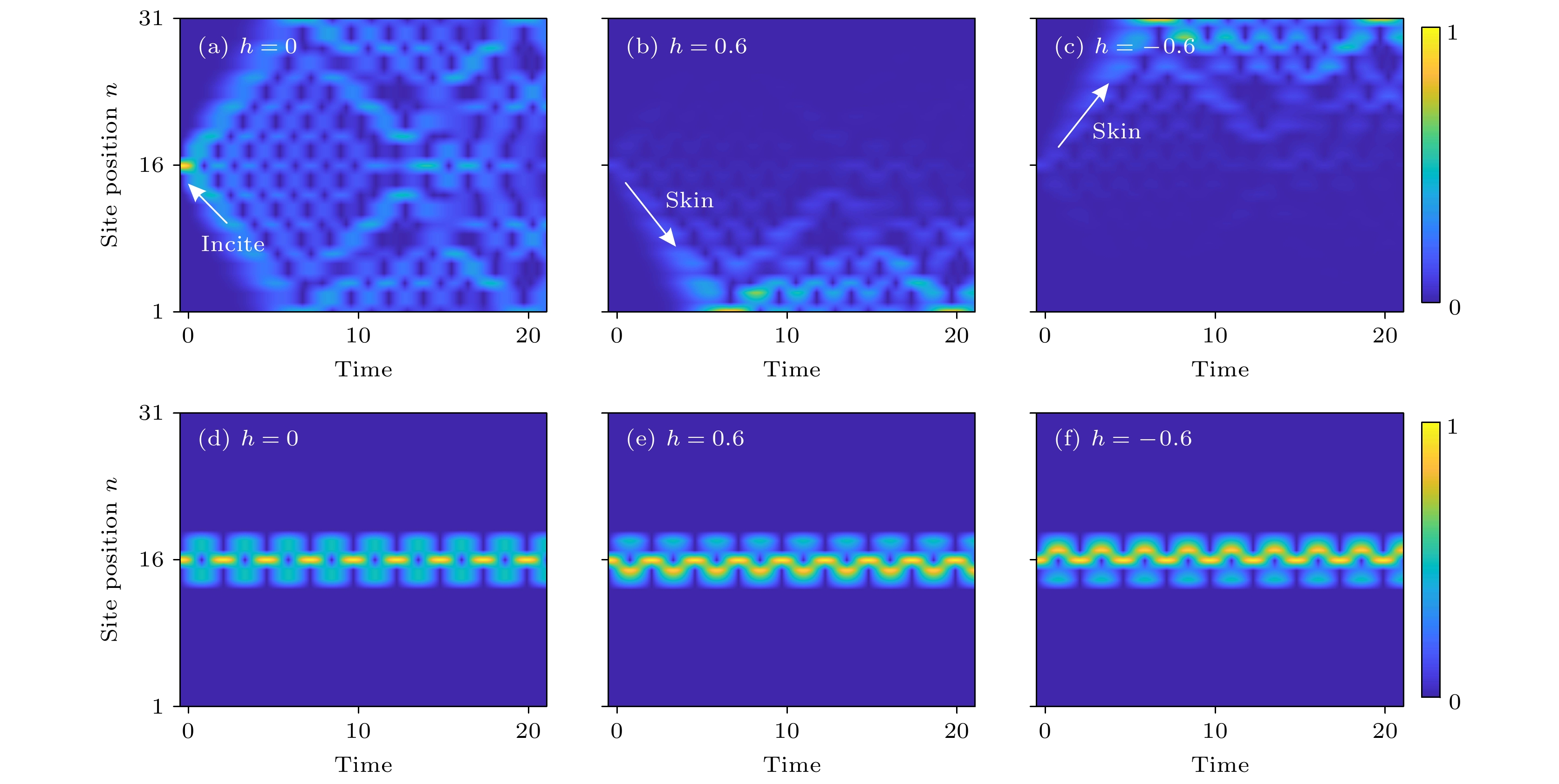-
能带理论在光学领域的应用为控制光传输提供了有效手段, 非厄米趋肤效应的发现扩展了传统能带理论的范畴, 能够实现新型光局域和单向传输现象. 然而在光学体系, 如何有效地产生并调控非厄米趋肤效应仍然是重要的研究主题. 本文研究了具有规范势的准一维菱形光晶格中的非厄米趋肤效应, 通过计算本征能谱、环绕数和模式演化特性, 发现规范势能够对趋肤效应强弱进行有效调节. 当规范势大小为π时, 趋肤效应被完全抑制, 而由Aharonov-Bohm笼效应引起的平带局域占主导. 利用间接耦合微环谐振腔阵列, 可同时产生合成光子规范势和非对称耦合, 为研究Aharonov-Bohm笼和趋肤效应的竞争机制提供了可能的实现方案. 本研究结果为利用规范势调控趋肤效应提供理论基础, 在发展片上非磁性单向传播器件也具有潜在的应用前景.
-
关键词:
- 非厄米趋肤效应 /
- Aharonov-Bohm笼 /
- 规范势 /
- 微环谐振腔
The application of energy band theory in optics provides an effective approach to modulating the flow of light. The recent discovery of non-Hermitian skin effect promotes the development of traditional energy band theory, which further enables an alternative way to realize light localization and unidirectional propagation. However, how to effectively generate and steer the non-Hermitian skin effect is still an important topic, especially in integrated optical systems. Here, we investigate the non-Hermitian skin effect in quasi-one-dimensional rhombic optical lattice with synthetic gauge potential. By calculating the eigenenergy spectra, spectral winding number, and wave dynamics, the gauge potential can be utilized to effectively tune the localization strength of skin modes. In particular, the skin effect is completely suppressed when the gauge potential in each plaquette is equal to π, while the flat-band localization caused by Aharonov-Bohm caging effect is dominant. By utilizing the indirectly coupled micro ring resonator array, the gauge potential and asymmetric coupling can be generated at the same time, which provides a potential experimental scheme to explore the competition between Aharonov-Bohm cage and skin effect. The present study provides an alternative way to steer the skin effect, which offers an approach to achieving the on-chip non-magnetic unidirectional optical devices.-
Keywords:
- non-Hermitian skin effect /
- Aharonov-Bohm cage /
- synthetic gauge potential /
- ring resonator array
[1] Joannopoulos. J D, Villeneuve. P R, Fan S 1997 Nature 386 143
 Google Scholar
Google Scholar
[2] Ke S, Zhao D, Liu J, Liu Q, Liao Q, Wang B, Lu P 2019 Opt. Express 27 13858
 Google Scholar
Google Scholar
[3] Yuan L, Lin Q, Xiao M, Fan S 2018 Optica 5 1396
 Google Scholar
Google Scholar
[4] Garanovich I L, Longhi S, Sukhorukov A A, Kivshar Y S 2012 Phys. Rep. 518 1
 Google Scholar
Google Scholar
[5] Qin C, Zhou F, Peng Y, Sounas D, Zhu X, Wang B, Dong J, Zhang X, Alu A, Lu P 2018 Phys. Rev. Lett. 120 133901
 Google Scholar
Google Scholar
[6] Mukherjee S, Spracklen A, Choudhury D, et al. 2015 Phys. Rev. Lett. 114 245504
 Google Scholar
Google Scholar
[7] Chen H, Yang N, Qin C, et al. 2021 Light Sci. Appl. 10 48
 Google Scholar
Google Scholar
[8] Weidemann S, Kremer M, Longhi S, Szameit A 2021 Nat. Photonics 15 576
 Google Scholar
Google Scholar
[9] Jorg C, Queralto G, Kremer M, et al. 2020 Light Sci. Appl. 9 150
 Google Scholar
Google Scholar
[10] Ke S, Zhao D, Fu J, Liao Q, Wang B, Lu P 2020 IEEE J. Sel. Top. Quantum Electron. 26 1
 Google Scholar
Google Scholar
[11] Liao K, Hu X, Gan T, Liu Q, Wu Z, Fan C, Feng X, Lu C, Liu Y-c, Gong Q 2020 Adv. Opt. Photonics 12 60
 Google Scholar
Google Scholar
[12] Leykam D, Yuan L 2020 Nanophotonics 9 4473
 Google Scholar
Google Scholar
[13] Shang C, Chen X, Luo W, Ye F 2018 Opt. Lett. 43 275
 Google Scholar
Google Scholar
[14] Dong J W, Chen X D, Zhu H, Wang Y, Zhang X 2017 Nat. Mater. 16 298
 Google Scholar
Google Scholar
[15] Fang K, Yu Z, Fan S 2012 Nat. Photonics 6 782
 Google Scholar
Google Scholar
[16] Zhou X, Lin Z K, Lu W, Lai Y, Hou B, Jiang J H 2020 Laser Photonics Rev. 14 2000010
 Google Scholar
Google Scholar
[17] Mittal S, Orre V V, Zhu G, Gorlach M A, Poddubny A, Hafezi M 2019 Nat. Photonics 13 692
 Google Scholar
Google Scholar
[18] Yao S, Wang Z 2018 Phys. Rev. Lett. 121 086803
 Google Scholar
Google Scholar
[19] Xiao L, Deng T, Wang K, Zhu G, Wang Z, Yi W, Xue P 2020 Nat. Phys. 16 761
 Google Scholar
Google Scholar
[20] Yang Z, Zhang K, Fang C, Hu J 2020 Phys. Rev. Lett. 125 226402
 Google Scholar
Google Scholar
[21] Kawabata K, Shiozaki K, Ueda M, Sato M 2019 Phys. Rev. X 9 041015
 Google Scholar
Google Scholar
[22] Wang H, Ruan J, Zhang H 2019 Phys. Rev. B 99 075130
 Google Scholar
Google Scholar
[23] Li L, Lee C H, Gong J 2020 Phys. Rev. Lett. 124 250402
 Google Scholar
Google Scholar
[24] Liu S, Shao R, Ma S, Zhang L, You O, Wu H, Xiang Y J, Cui T J, Zhang S 2021 Research (Wash D C) 2021 5608038
 Google Scholar
Google Scholar
[25] Zhang L, Yang Y, Ge Y, et al. 2021 Nat. Commun. 12 6297
 Google Scholar
Google Scholar
[26] Gao P, Willatzen M, Christensen J 2020 Phys. Rev. Lett. 125 206402
 Google Scholar
Google Scholar
[27] Wang S, Qin C, Wang B, Lu P 2018 Opt. Express 26 19235
 Google Scholar
Google Scholar
[28] Song Y, Liu W, Zheng L, Zhang Y, Wang B, Lu P 2020 Phys. Rev. Appl. 14 064076
 Google Scholar
Google Scholar
[29] Lin Z, Ding L, Chen S, Li S, Ke S, Li X, Wang B 2021 Phys. Rev. A 103 063507
 Google Scholar
Google Scholar
[30] Song Y, Chen Y, Xiong W, Wang M 2022 Opt. Lett. 47 1646
 Google Scholar
Google Scholar
[31] Jiang H, Lang L J, Yang C, Zhu S L, Chen S 2019 Phys. Rev. B 100 054301
 Google Scholar
Google Scholar
[32] Lu M, Zhang X X, Franz M 2021 Phys. Rev. Lett. 127 256402
 Google Scholar
Google Scholar
[33] Peng Y, Jie J, Yu D, Wang Y 2022 arXiv: 2201.10318
[34] Longhi S 2014 Opt. Lett. 39 5892
 Google Scholar
Google Scholar
[35] Mukherjee S, Thomson R R 2015 Opt. Lett. 40 5443
 Google Scholar
Google Scholar
[36] Kremer M, Petrides I, Meyer E, Heinrich M, Zilberberg O, Szameit A 2020 Nat. Commun. 11 907
 Google Scholar
Google Scholar
[37] Zhang K, Yang Z, Fang C 2020 Phys. Rev. Lett. 125 126402
 Google Scholar
Google Scholar
[38] Okuma N, Kawabata K, Shiozaki K, Sato M 2020 Phys. Rev. Lett. 124 086801
 Google Scholar
Google Scholar
[39] Wang P, Jin L, Song Z 2019 Phys. Rev. A 99 062112
 Google Scholar
Google Scholar
[40] Zhang Z X, Huang R, Qi L, Xing Y, Zhang Z J, Wang H F 2020 Ann. Phys. 533 2000272
 Google Scholar
Google Scholar
[41] Hafezi M, Demler E A, Lukin M D, Taylor J M 2011 Nat. Phys. 7 907
 Google Scholar
Google Scholar
[42] Hafezi M, Mittal S, Fan J, Migdall A, Taylor J M 2013 Nat. Photonics 7 1001
 Google Scholar
Google Scholar
-
图 2 周期边界条件(蓝色实心圆)和开放边界条件(红色空心圆)下的复能谱 (a)—(c) 分别对应厄米情况下(h = 0)规范势 φ = 0, 0.5π, π 的能谱图; (d)—(f) 分别对应非厄米情况下(h = 0.6)规范势 φ = 0, 0.5π, π 的能谱图
Fig. 2. Complex energy spectra under periodic (blue solid circles) and open boundary conditions (red hollow circles): (a)–(c) Energy spectra for Hermitian cases (h = 0) with φ = 0, 0.5π, π, respectively; (d)–(f) energy spectra for non-Hermitian cases (h = 0.6) with φ = 0, 0.5π, π, respectively.
图 3 不同参数下的本征模式分布和MPR变化 (a)—(c) φ = 0时, h 取0, 0.6, 1.2时的本征模式分布; (d)—(f) φ = π时, h 取0, 0.6, 1.2时的本征模式分布; (g) 规范势 φ = 0 时MPR随h变化情况; (h) 规范势 φ = π 时MPR随h变化情况; 蓝色圆点表示数值计算的结果, 红色实线表示回归分析的结果
Fig. 3. The distribution of eigenmodes and the variation of MPR via h under different parameters: (a)–(c) the distributions of eigenmodes with φ = 0 as h = 0, 0.6, and 1.2, respectively; (d)–(f) the distributions of eigenmodes with φ = π as h = 0, 0.6, and 1.2, respectively; (g) MPR as a function of h for φ = 0; (h) MPR as a function of h for φ = π. The blue dots indicate the result of numerical calculation and the red solid lines indicate the result of regression.
图 4 不同参数下的单点激发随时间演化特性 (a)—(c) 规范势 φ = 0 时h 分别取0, 0.6, –0.6时的演化; (d)—(f) 规范势 φ = π 时h 分别取0, 0.6, –0.6时的演化
Fig. 4. Time-dependent wave dynamics for single-site injection with different parameters: (a)–(c) For φ = 0 with h = 0, 0.6, –0.6, respectively; (d)–(f) for φ = π with h = 0, 0.6, –0.6, respectively.
图 5 单点激发下一段时间演化后(时间取20)的输出模场分布随规范势φ的变化情况. 格点总数N = 31, 激发位置始终位于结构的正中间A格点(n = 16), 选取固定不变的趋肤强度h = 0.6, 模场强度已做归一化处理
Fig. 5. The variation of the output field distribution with the gauge potential φ after a period of evolution under single-site excitation (Time is 20). The total number of site N = 31. The field is incident from the middle A site of the structure (n = 16), the skin strength is fixed at h = 0.6, and the intensity of the field is normalized.
图 6 微环耦合特性示意图 (a) 一维环形谐振腔阵列演示传输矩阵法的原理示意图; (b) 利用连接环实现不同类型的耦合
Fig. 6. Schematic diagram of microring coupling characteristics: (a) Schematic diagram of the 1D array of ring resonators to demonstrate the principle of the transmission matrix method; (b) implementation of different types of coupling using link rings.
图 7 耦合微环谐振腔阵列的趋肤效应模拟结果 (a) 菱形微环谐振腔阵列示意图; (b)—(g) 分别展示了规范势φ和用于引入增益损耗的折射率虚部大小γ取不同值时的模场强度空间分布(|E|2); (h) S21随φ的变化趋势
Fig. 7. Simulation results based on coupled resonator arrays: (a) Geometry of non-Hermitian quasi 1D rhombic chain with ring resonator arrays; (b)–(g) the spatial intensity (|E|2) distributions of light with different values of gauge potential φ and the imaginary index γ used to introduce gain and loss; (h) the trend of S21 with φ.
-
[1] Joannopoulos. J D, Villeneuve. P R, Fan S 1997 Nature 386 143
 Google Scholar
Google Scholar
[2] Ke S, Zhao D, Liu J, Liu Q, Liao Q, Wang B, Lu P 2019 Opt. Express 27 13858
 Google Scholar
Google Scholar
[3] Yuan L, Lin Q, Xiao M, Fan S 2018 Optica 5 1396
 Google Scholar
Google Scholar
[4] Garanovich I L, Longhi S, Sukhorukov A A, Kivshar Y S 2012 Phys. Rep. 518 1
 Google Scholar
Google Scholar
[5] Qin C, Zhou F, Peng Y, Sounas D, Zhu X, Wang B, Dong J, Zhang X, Alu A, Lu P 2018 Phys. Rev. Lett. 120 133901
 Google Scholar
Google Scholar
[6] Mukherjee S, Spracklen A, Choudhury D, et al. 2015 Phys. Rev. Lett. 114 245504
 Google Scholar
Google Scholar
[7] Chen H, Yang N, Qin C, et al. 2021 Light Sci. Appl. 10 48
 Google Scholar
Google Scholar
[8] Weidemann S, Kremer M, Longhi S, Szameit A 2021 Nat. Photonics 15 576
 Google Scholar
Google Scholar
[9] Jorg C, Queralto G, Kremer M, et al. 2020 Light Sci. Appl. 9 150
 Google Scholar
Google Scholar
[10] Ke S, Zhao D, Fu J, Liao Q, Wang B, Lu P 2020 IEEE J. Sel. Top. Quantum Electron. 26 1
 Google Scholar
Google Scholar
[11] Liao K, Hu X, Gan T, Liu Q, Wu Z, Fan C, Feng X, Lu C, Liu Y-c, Gong Q 2020 Adv. Opt. Photonics 12 60
 Google Scholar
Google Scholar
[12] Leykam D, Yuan L 2020 Nanophotonics 9 4473
 Google Scholar
Google Scholar
[13] Shang C, Chen X, Luo W, Ye F 2018 Opt. Lett. 43 275
 Google Scholar
Google Scholar
[14] Dong J W, Chen X D, Zhu H, Wang Y, Zhang X 2017 Nat. Mater. 16 298
 Google Scholar
Google Scholar
[15] Fang K, Yu Z, Fan S 2012 Nat. Photonics 6 782
 Google Scholar
Google Scholar
[16] Zhou X, Lin Z K, Lu W, Lai Y, Hou B, Jiang J H 2020 Laser Photonics Rev. 14 2000010
 Google Scholar
Google Scholar
[17] Mittal S, Orre V V, Zhu G, Gorlach M A, Poddubny A, Hafezi M 2019 Nat. Photonics 13 692
 Google Scholar
Google Scholar
[18] Yao S, Wang Z 2018 Phys. Rev. Lett. 121 086803
 Google Scholar
Google Scholar
[19] Xiao L, Deng T, Wang K, Zhu G, Wang Z, Yi W, Xue P 2020 Nat. Phys. 16 761
 Google Scholar
Google Scholar
[20] Yang Z, Zhang K, Fang C, Hu J 2020 Phys. Rev. Lett. 125 226402
 Google Scholar
Google Scholar
[21] Kawabata K, Shiozaki K, Ueda M, Sato M 2019 Phys. Rev. X 9 041015
 Google Scholar
Google Scholar
[22] Wang H, Ruan J, Zhang H 2019 Phys. Rev. B 99 075130
 Google Scholar
Google Scholar
[23] Li L, Lee C H, Gong J 2020 Phys. Rev. Lett. 124 250402
 Google Scholar
Google Scholar
[24] Liu S, Shao R, Ma S, Zhang L, You O, Wu H, Xiang Y J, Cui T J, Zhang S 2021 Research (Wash D C) 2021 5608038
 Google Scholar
Google Scholar
[25] Zhang L, Yang Y, Ge Y, et al. 2021 Nat. Commun. 12 6297
 Google Scholar
Google Scholar
[26] Gao P, Willatzen M, Christensen J 2020 Phys. Rev. Lett. 125 206402
 Google Scholar
Google Scholar
[27] Wang S, Qin C, Wang B, Lu P 2018 Opt. Express 26 19235
 Google Scholar
Google Scholar
[28] Song Y, Liu W, Zheng L, Zhang Y, Wang B, Lu P 2020 Phys. Rev. Appl. 14 064076
 Google Scholar
Google Scholar
[29] Lin Z, Ding L, Chen S, Li S, Ke S, Li X, Wang B 2021 Phys. Rev. A 103 063507
 Google Scholar
Google Scholar
[30] Song Y, Chen Y, Xiong W, Wang M 2022 Opt. Lett. 47 1646
 Google Scholar
Google Scholar
[31] Jiang H, Lang L J, Yang C, Zhu S L, Chen S 2019 Phys. Rev. B 100 054301
 Google Scholar
Google Scholar
[32] Lu M, Zhang X X, Franz M 2021 Phys. Rev. Lett. 127 256402
 Google Scholar
Google Scholar
[33] Peng Y, Jie J, Yu D, Wang Y 2022 arXiv: 2201.10318
[34] Longhi S 2014 Opt. Lett. 39 5892
 Google Scholar
Google Scholar
[35] Mukherjee S, Thomson R R 2015 Opt. Lett. 40 5443
 Google Scholar
Google Scholar
[36] Kremer M, Petrides I, Meyer E, Heinrich M, Zilberberg O, Szameit A 2020 Nat. Commun. 11 907
 Google Scholar
Google Scholar
[37] Zhang K, Yang Z, Fang C 2020 Phys. Rev. Lett. 125 126402
 Google Scholar
Google Scholar
[38] Okuma N, Kawabata K, Shiozaki K, Sato M 2020 Phys. Rev. Lett. 124 086801
 Google Scholar
Google Scholar
[39] Wang P, Jin L, Song Z 2019 Phys. Rev. A 99 062112
 Google Scholar
Google Scholar
[40] Zhang Z X, Huang R, Qi L, Xing Y, Zhang Z J, Wang H F 2020 Ann. Phys. 533 2000272
 Google Scholar
Google Scholar
[41] Hafezi M, Demler E A, Lukin M D, Taylor J M 2011 Nat. Phys. 7 907
 Google Scholar
Google Scholar
[42] Hafezi M, Mittal S, Fan J, Migdall A, Taylor J M 2013 Nat. Photonics 7 1001
 Google Scholar
Google Scholar
计量
- 文章访问数: 7542
- PDF下载量: 361
- 被引次数: 0














 下载:
下载:






